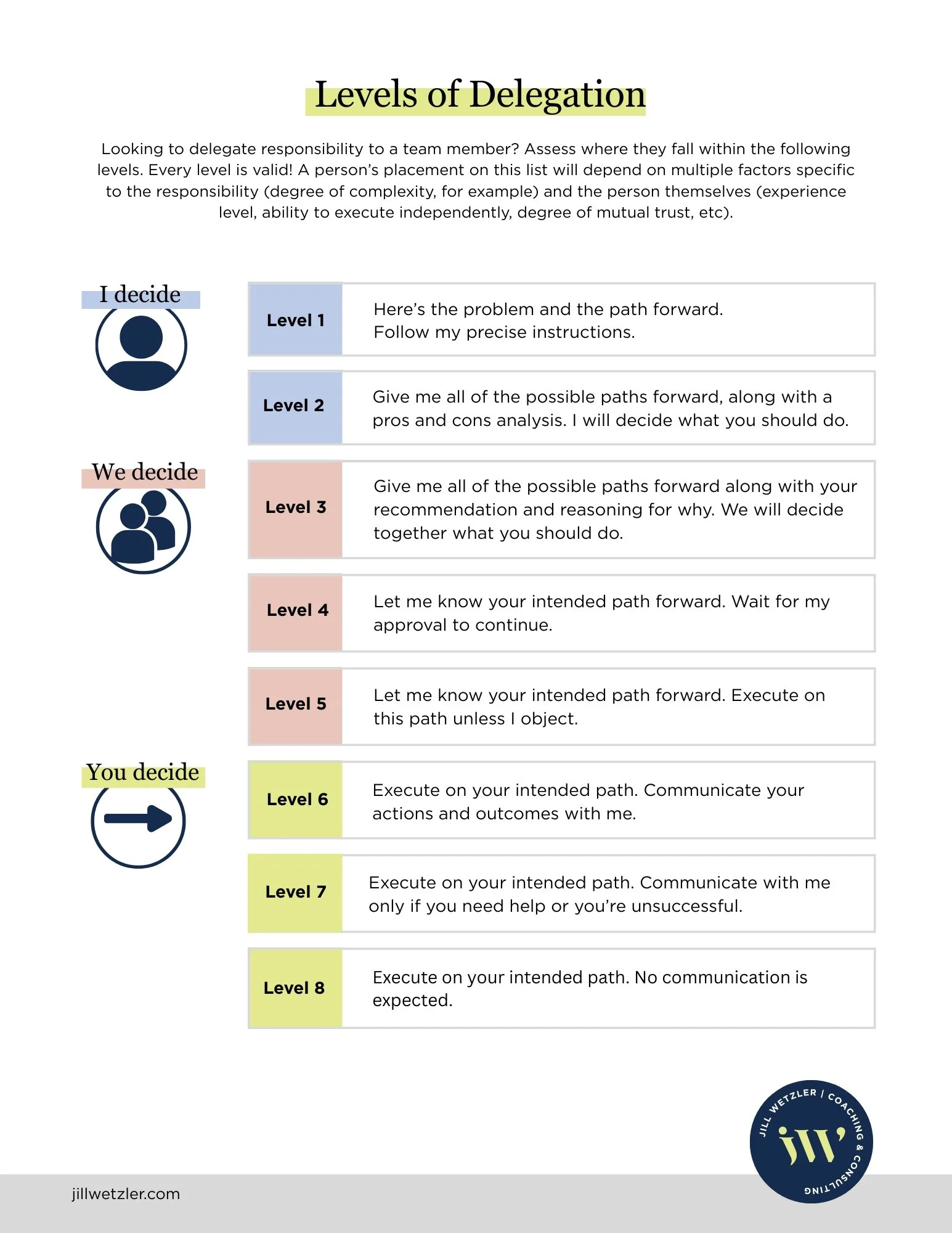The Art of Delegation
Have you ever tried to give someone a task and found yourself struggling to determine how much direction to give? On the one hand, you’re eager to give this member of your team some autonomy and a growth opportunity, which implies you need to be hands-off. On the other hand, you want them to have enough direction, feel supported, and ultimately succeed at this task, implying you need to be hands-on. You worry about being a micromanager, but you don’t want to hang them out to dry. You know better than to cling to control, but you also know from experience the roadblocks they’re likely to encounter. You don’t have time to do it yourself, but if it’s done incorrectly it might reflect poorly on you both. So how do you find the right balance in your attempts to delegate?
Levels of Delegation
One of the most helpful approaches to delegation I’ve encountered is a combination of Alan Chapman’s “10 levels of delegation” (there’s an entire course on this which can be found here) and Paul Hersey’s Four Styles of Situational Leadership. Inspired by this work, I thought about all of the ways I’ve delegated responsibilities to others throughout my career and created my own version of this framework.
We might think of delegating as a prescriptive set of instructions: do this exactly the way I tell you to. Or we might think of it as lightening our load: I’m overwhelmed, can you take this off my plate so I don’t have to think about it anymore? But there’s a whole scale in between those two approaches to delegation. In some cases, I am the decision maker. In other cases we decide together. In the highest stages of delegation, I hand off all decision making and determine how informed I want to be.
We might be tempted to say that level 1 delegation is bad. It sure sounds like micromanagement – and in some cases it is! However, there’s a time and place for every level on this scale.
When I was given my first task at my first engineering internship, it was a level 1 task. That’s because the point was not for me to solve the problem myself, the point was to get me familiar with their source control in an unfamiliar codebase using a programming language I was rusty in. As I became more comfortable, the direction I was given felt more like a level 3, then 4, and then 5. In just a few weeks I was cruising through my summer project with only occasional oversight.
With a month left to go in my internship, the software team had run out of things for me to do. Someone from the hardware department asked for a software engineer to help out with a demo they were working on, and I was volunteered. Just like that, I was back at a level 1, working with a whole new team and a new set of technologies. That meant space to learn again!
Putting It Into Practice
Where a team member you are supporting falls on this scale will depend on a number of factors, including their experience level, the complexity of the responsibility or task, and the degree of trust you have in each other. When delegating a specific responsibility, consider where they fall on this scale and examine why. If they’re at a lower level, is it because they are new to the team or the concepts? Is it because they haven’t earned (or rebuilt) enough trust yet? Or, be honest, are you trying to hang on to a little bit of control? Examine your own anxiety in this moment and determine whether it’s warranted.
Then ask yourself, what would you need to see from them or what feedback would you need to hear from their peers to comfortably move them to the next level of delegation for a similarly scoped responsibility? What types of tasks could you delegate to them that would bump them up a few levels (potentially relieving you of some of your responsibilities)? What types of tasks could you delegate that would bump them down a few levels (potentially giving them a new skill to learn)? How might either of these actions align with fulfilling their own career goals? Furthermore, what profile of person might you need to hire in order to be able to scale yourself effectively (i.e. do you need someone you can delegate to at a level 2 or a level 7)?
I encourage you to not just consider these levels but actually use them (responsibly!) in growth discussions with your direct reports. You can increase your chances of success on a given task by clarifying which one of you is the decision-maker for aspects of the task and, importantly, why. It can be empowering for your direct report to understand your intentions to move them gradually up the scale. It can even be a useful tool in the context of a performance conversation, to explain the gap between where they’re currently operating and where their job expectations indicate they should be. In this latter case, you’ll want to invite them to reflect on the reasons for this gap and to be forthcoming about the support they need from you.
In fact, in all cases where you use this framework, it’s an opportunity for a bi-directional feedback and/or coaching conversation. Explore:
What are their career goals and how do those align with your goals for them?
What anxieties do they have around gaining more decision-making power, and what are the (valid) reasons for you maintaining your level of involvement?
Do they want even more autonomy than what you’re granting them, and is that a reasonable request that you can both agree to experiment with in some way?
What type of support do they need, and what are you committing to in order to ensure all-around success?
Having this type of candid discussion and agreeing on a path forward together will not only be empowering for your direct report, but it just might show you that you can delegate more than you think.


